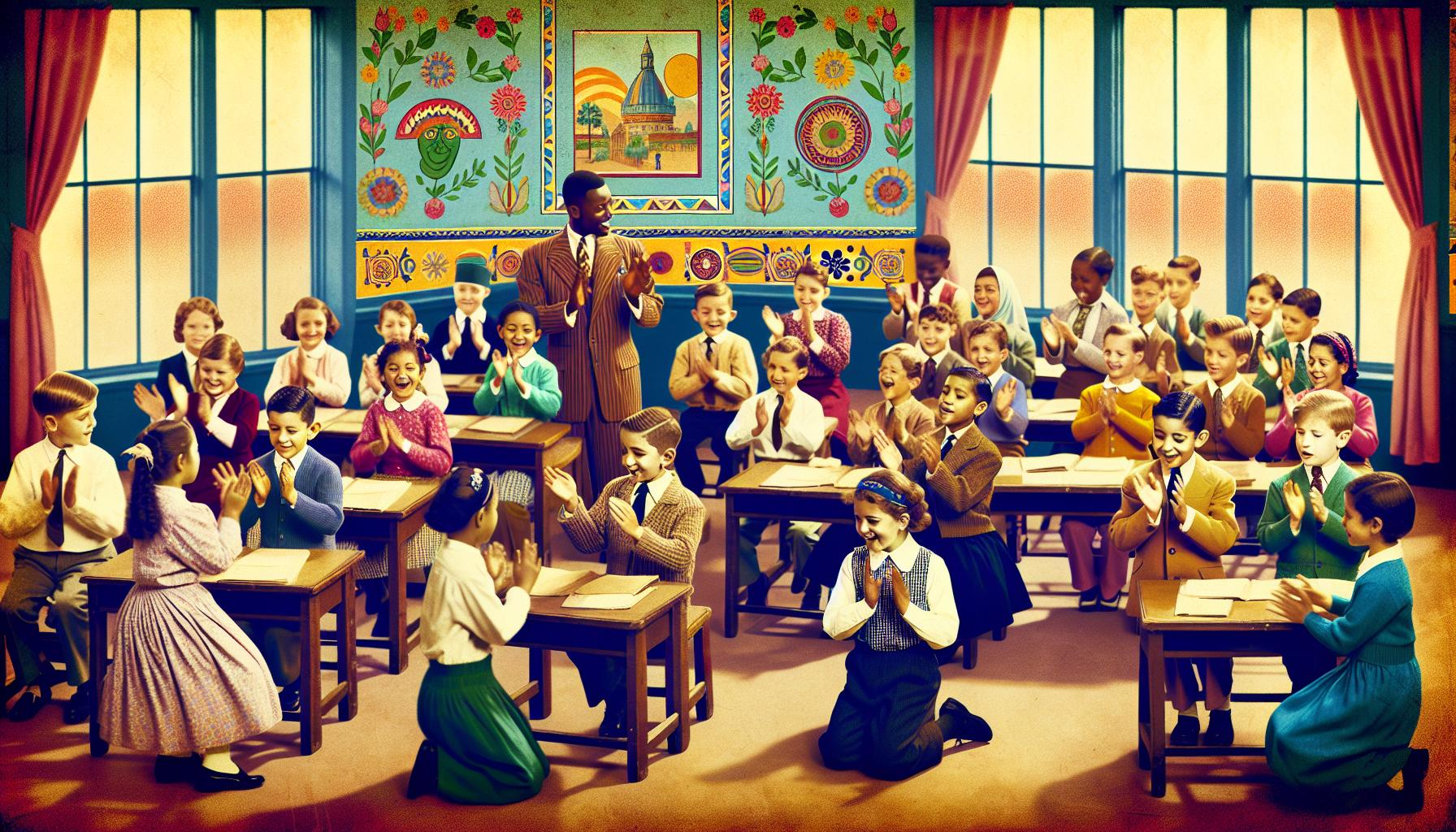Easy Chants for Engaging Elementary Learners
Chants can transform your elementary classroom into a vibrant learning environment. They’re not just fun; they’re a secret weapon for engaging students and enhancing memory. Imagine your class eagerly reciting educational rhymes that stick like glue—sounds great, doesn’t it?
Benefits of Chants for Elementary Students
When you incorporate chants into your classroom routine, you’ll notice a slew of benefits that directly impact your students’ learning experience. Chants can dramatically boost students’ retention of material. By setting key concepts to a catchy rhythm, you help students memorize information in a method that’s far more engaging than rote memorization.
Improved Focus and Engagement
- Students are more attentive
- Energy levels in the classroom rise
- Learning becomes an active rather than passive activity
Chants can be a game-changer in maintaining student focus. You’ve probably seen how kids can lose interest during traditional lectures. With chants, they’re actively participating, which keeps energy levels high and minds sharply focused on the task at hand.
Enhanced Memory and Recall
The rhythmic nature of chants promotes better memory retention and recall. This is crucial for subjects where sequentially linked facts must be remembered and for ensuring long-term memory of foundational knowledge.
Promoting Language Development
- Phonemic awareness is sharpened
- Vocabulary is expanded with each new chant
- Pronunciation skills are honed
As you chant with elementary students, you’re not just covering course material—you’re bolstering their language skills. For young learners, the repetitive and rhythmic aspects of chants help improve phonemic awareness. They’ll pick up new words and hone their pronunciation skills without even realizing they’re learning.
Chants also encourage students to work together in unison, fostering a sense of community and cooperation that’s essential to a positive classroom environment.
- Self-esteem grows with each successful recitation
- Public speaking skills develop early on
Students may feel a surge of pride and confidence after successfully reciting a chant. Mastery of these chants can translate into improved public speaking skills and increased self-esteem.
By introducing chants into your teaching strategy, you’ll provide an educational experience that’s as entertaining as it is effective. Kids are guaranteed to look forward to these engaging breaks in their routine that also serve to reinforce critical knowledge and skills.
How Chants Engage Students

Chants have a unique way of grabbing students’ attention and keeping them hooked. When you integrate rhythmic recitation into learning, you’re not just asking students to repeat information; you’re inviting them to be part of a dynamic, shared experience. This interactive approach can turn a regular classroom into an energetic learning environment.
As you introduce chants, you’ll notice that students are more likely to pay attention and participate. This is because chanting breaks the monotony of traditional teaching methods. Students enjoy the change of pace – they’re not just sitting and listening, they’re moving and responding. This mix of physical activity and vocal repetition increases engagement and helps anchor the material deeper in their memories.
But that’s not all. Chants also capitalize on the power of peer influence. When the whole class participates, the collective energy can encourage even the most reticent of students to join in. The rhythmic nature of chanting makes this collective activity fun, and as a result, you’ll witness a rise in enthusiasm across the board. The beat and repetition inherent in chants make memorization feel more like a game than a task.
Chants can also be incredibly versatile, serving a variety of educational purposes. Whether you’re looking to reinforce math concepts, language rules, or historical facts, tailoring chants to the subject matter makes the learning process more vibrant and memorable. Try incorporating hand gestures or movements, and you’ll see an immediate boost in student interaction and retention.
Keep in mind that chants can be adapted for any learning style. Auditory learners will appreciate the sounds and rhythms, visual learners can benefit from accompanying gestures, and kinesthetic learners get to move around and feel the beat.
By making chants a regular part of your teaching toolkit, you’re ensuring that students are not only learning but also having fun in the process. Their smiles and eager participation will be the clearest indicators that your lessons are striking the right chord.
Enhancing Memory with Chants

Imagine your students recalling historical dates, scientific terms, and mathematical formulas with ease. When you incorporate chanting into your teaching toolkit, this becomes a real possibility. Chants stick in the mind, creating a mental hook for information that might otherwise slip away.
The rhythmic and repetitive nature of chants aids memory by providing a structure for students to latch onto. It’s not just about the facts and figures but about the way they’re presented. Chants turn data into a memorable melody, and before you know it, your students can recite the material without even glancing at their textbooks.
- Memory is boosted by patterns, and chants create patterns.
- The use of rhyme and rhythm makes details easier to remember.
- Melody and repetition are keys to retention.
Think about the alphabet song – it’s the perfect example of how a simple tune helps us memorize. Your classroom chants can serve a similar purpose. From multiplication tables to language rules, every subject has its facts that chant can transform.
| Learning Element | Impact of Chants |
|---|---|
| Retention | Increased |
| Engagement | Improved |
| Recall | Enhanced |
When kids chant together, they’re doing more than just memorizing; they’re building connections. Group recitation reinforces the material, as hearing their peers can help them correct and improve their own performance. It’s peer learning and memory work combined in the most fun and interactive way.
To truly optimize memory through chanting, ensure the chants are:
- Short
- Catchy
- Age-appropriate
- Integrated with movements or actions
With these features, chants can become a powerful learning ally. They’ll help your students master the material at hand and perhaps even unlock a passion for learning that will grow with them throughout their academic journey. And isn’t igniting that spark what teaching’s all about?
Incorporating Chants into the Classroom

Harnessing the power of chants in your classroom is more straightforward than you might think. Picture a routine morning where you’re welcomed by eager faces, ready to sing their way into learning. That’s the charm of integrating chants with the usual lesson plans; they seamlessly blend education with enthusiasm.
Kickstart the Day with Thematic Chants
Start every day off with a thematic chant that aligns with whatever you’re diving into. If fractions are the flavor of the day, cook up a simple jingle that lays out the basics. These chants work like magic for setting the tone and getting those young minds tuned in and ready to focus.
- Keep the lyrics relatable
- Ensure each chant has a consistent rhythm
- Attach motions to go with words for kinesthetic appeal
Making Transitions Smoother
When it’s time to shift gears, chants can be your best tool. You can smoothly transition from one activity to the next by chanting instructions or creating a song that encapsulates the essence of the next task. It’s a fun way to keep energy levels high and maintain an upbeat mood throughout transitions.
Subject-Specific Chants
Delving into different subjects doesn’t have to be a silent, daunting affair. Why not introduce a history chant that encapsulates key events? Or a science chant that lays out the scientific method? Customized chants for subjects not only make recall easier but can reignite interest in topics that may otherwise seem dry.
- Creativity is key – tailor chants to each subject
- Encourage student input for personalization
- Use melodies that are easy to remember
When you’re planning how to infuse chants into your teaching, think about the distinct learning styles in your classroom. Some students respond well to visual stimuli, while others might need to be more hands-on. Include elements that cater to a diverse range of learners, ensuring that each child finds a connection to the content through the chant. The goal is to keep it simple, engaging, and most importantly, educational.
Fun and Educational Chants for Elementary Students

Imagine starting your day with a room full of energy; chants can bring that vibe into an elementary classroom. Engaging chants aren’t just catchy tunes; they’re powerful tools for learning. Here’s how to create fun and educational chants that’ll stick with your students long after they’ve left the classroom.
Start with the Basics
Keep it simple and memorable. Your chants should be easy to follow so every student can join in. Here are a few pointers:
- Choose topics that resonate with kids’ everyday experiences
- Craft lyrics that rhyme and repeat; repetition boosts memory
- Set chants to familiar tunes or rhythmic beats
As you brainstorm, involve your students in the process. They’ll love contributing ideas, and it’ll make the chants more personal.
Incorporate Movement
Children learn best when they’re active. Pairing chants with movements or hand gestures can help students:
- Internalize concepts physically and mentally
- Stay focused and attentive
- Release extra energy in a controlled way
Whether it’s a song about numbers that includes counting on fingers or a weather chant that uses body movements to depict different conditions, integrating action with words enriches the learning experience.
Subject-Specific Chants
Tie chants to your curriculum for maximum impact. Use them to introduce new subjects or reinforce key points:
- Math chants for times tables or measurement units
- Science chants covering the life cycle of a butterfly or plant parts
- English chants to drill spelling rules or punctuation
Effective Transition Tools
Chants aren’t just for lessons. Use them to signal transitions between activities. A cleanup chant or an end-of-break tune helps students anticipate what’s next, reducing classroom chaos.
By incorporating chants, you turn the everyday curriculum into a lively exchange of knowledge. Remember to tailor your chants to your classroom’s unique needs and watch how these rhythmical lines can transform learning into an adventure.







